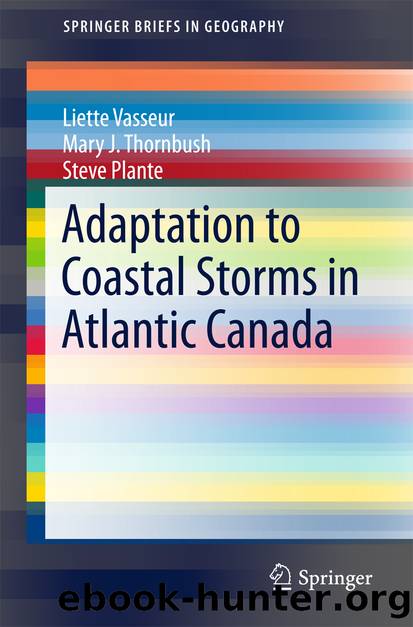Adaptation to Coastal Storms in Atlantic Canada by Liette Vasseur Mary J. Thornbush & Steve Plante

Author:Liette Vasseur, Mary J. Thornbush & Steve Plante
Language: eng
Format: epub
Publisher: Springer International Publishing, Cham
5.4 Experiences and Lessons Learned from Coastal Storms
People who are accustomed to living at the coast are willing to accept both the positive and negative aspects of their choice. Ueda and Torigoe (2012) show that victims of tsunamis tend to accept their vulnerability as a condition of accessing the fertility of the sea. Authors have noted the ongoing conflict of occupation versus risks at the coast, such as at the Praia de Faro in the Portuguese southern coast (Costas et al. 2015). These authors report that risk perception in Portugal is affected by place attachment as well as underestimated impacts/lessons learned and cultural aspects in addition to the imposition of relocation measures as part of risk mitigation. Behavioral change is key to adapting at various levels and is seen as reflecting personal and/or cultural attachments that may be occupation-based, as for example of fishers in resource-dependent communities (Forster et al. 2014).
There is a recent emerging strand of research that recognizes socially constructed knowledge as part of social representation that is based on understandings by subgroups (e.g., Moloney et al. 2014); and this could affect the experience of different cultural groups as well as age-based and gender-specific groups within communities. For instance, risks may be socially constructed so that risk communication needs to be integrated into the entire risk governance process, from preassessment to appraisal to characterization/evaluation and finally to management (Kane et al. 2014).
The perception and responses of locals provide important (site-specific) inputs to sustainable (adaptive) management, allowing for the identification of needs as well as challenges and opportunities that can support effective decision making (cf. Munji et al. 2014). For instance, a series of workshops with residents (in Boston, Massachusetts, Douglas et al. 2012) reveals a lack of knowledge about resources and adaptation because community members are not included in the planning process, even though there is a general sentiment of eagerness to learn and become actively involved in the decision-making process. Among the lessons learned in their work was that local residents should be engaged early in the planning process, as this can foster trust and consensus (enabling progression from the conceptual to implementation stages) as well as offer opportunities for education . It is known (e.g., MacInnis et al. 2015) that American public opinion, for instance, can be influenced by endorsement, as when preparation is endorsed by researchers or government (rather than religious or business leaders), and this may be an issue of trusting people in authority. The availability of information (to residents and decision makers) is another factor that affects perception (Dempsey and Fisher 2005).
Individuals were mostly self-sufficient in their experiences of the 2010 storms, although there was some feeling of community cohesion. Others, however, felt that they could have drawn on others (friends and neighbors) for help. However, having experienced storms previously better prepared individuals so that they became more attentive to changing weather conditions and had an action plan for their responses at an individual level. This was not evident at the community level,
Download
This site does not store any files on its server. We only index and link to content provided by other sites. Please contact the content providers to delete copyright contents if any and email us, we'll remove relevant links or contents immediately.
The Lonely City by Olivia Laing(4567)
Animal Frequency by Melissa Alvarez(4148)
All Creatures Great and Small by James Herriot(3986)
Walking by Henry David Thoreau(3681)
Exit West by Mohsin Hamid(3634)
Origin Story: A Big History of Everything by David Christian(3472)
COSMOS by Carl Sagan(3346)
How to Read Water: Clues and Patterns from Puddles to the Sea (Natural Navigation) by Tristan Gooley(3239)
Hedgerow by John Wright(3106)
How to Do Nothing by Jenny Odell(3101)
The Inner Life of Animals by Peter Wohlleben(3099)
How to Read Nature by Tristan Gooley(3077)
Project Animal Farm: An Accidental Journey into the Secret World of Farming and the Truth About Our Food by Sonia Faruqi(3017)
Origin Story by David Christian(2991)
Water by Ian Miller(2950)
A Forest Journey by John Perlin(2914)
The Plant Messiah by Carlos Magdalena(2745)
A Wilder Time by William E. Glassley(2689)
Forests: A Very Short Introduction by Jaboury Ghazoul(2671)
